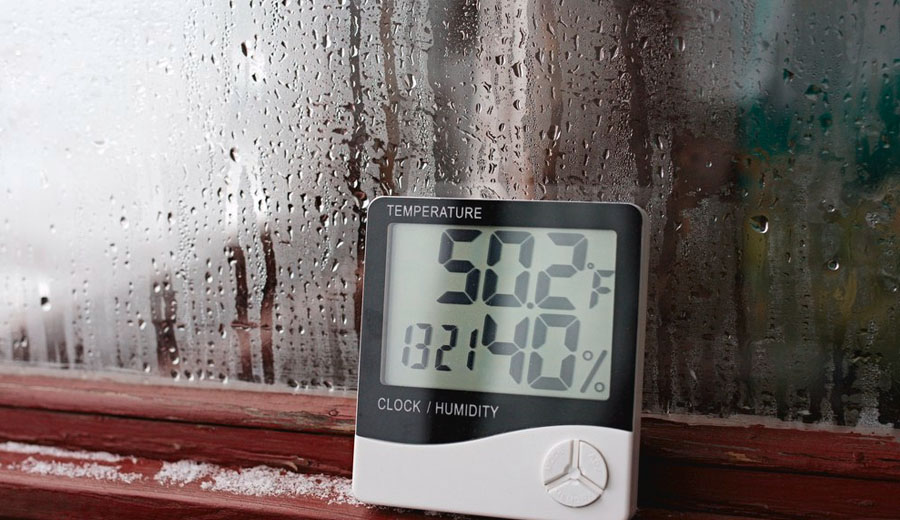A major downside of living in Kolkata is the humid environment throughout the year. This results in constant sweating (except in air-conditioned rooms).
Constant sweating saps our energy and our productivity suffers. Besides, high humidity is a health hazard as it triggers allergies and respiratory tract infections due to higher dust mites and mould spores in the air.
High humidity also affects the structural integrity of your home. Maintaining indoor humidity levels, ideally between 30 and 50 percent, is recommended for optimal comfort and well-being.
In the next 4 minutes, we will discuss ways of detecting high humidity levels and how to control them for a comfortable indoor environment conducive to your well-being.
There are several ways to control high indoor humidity besides air conditioning.
How to Detect High Indoor Humidity
Humidity levels can be measured using a hygrometer. It is available in digital and analog forms at hardware stores or online.
However, there are other tell-tale signs of high humidity in your home.
Paint or wallpaper coming off
High humidity can cause paint to peel off and wallpapers to become loose and wrinkled. These signs are more common in areas of high humidity like bathrooms and kitchens.
Warping and swelling of wood
Another tell-tale sign of high indoor humidity is the warping and swelling of wood in doors and furniture due to the accumulation of moisture. We all are familiar with the struggle of closing wooden doors or windows during the monsoons.
Mould and mildew
Mould and mildew appear in black, green, or white patches on surfaces and are a clear sign of high humidity. The likely areas to detect these should include bathrooms, kitchens, basements, and windows. Keep an eye on wooden furniture for them too.
Usually, a musty odour is noticeable in humid areas of your home. The typical odour is the result of mould and mildew,
Increased pest activity
Highly humid environments can easily attract pests like dust mites, cockroaches, and termites. Any increase in pest activity, especially in damp areas, is a sign to address humidity-related issues in your home.
Damp clothes, rusty metal surfaces
High humidity particularly damages fabric. We know of the disagreeable smell of fabrics during the monsoon. This is because of the fungus that grows on the clothes.
High humidity doesn’t allow bathroom linens to dry up fast.
Rust on metal surfaces, especially in damp areas like basements and bathrooms, indicates abnormal humidity levels.
High humidity levels are not good for electronic gadgets such as computers, TVs, and mobile phones. Regularly check these items for any condensation inside.
How You Can Control High Indoor Humidity
If you detect any sign of high humidity inside your home, you should immediately take the necessary steps to mitigate the problem.
Let us now discuss how you can do the same.
Kitchen and bathroom ventilation
Cooking activities generate a lot of moisture and a chimney/hood does a good job of removing them. While cooking, cover the pots to contain the steam and control the moisture being released into the air.
Similarly, taking a hot shower also generates a lot of moisture. Install an exhaust fan in the shower cubicle to release the moisture outside.
Consider opening windows and letting in as much fresh air as possible, when outdoor humidity is low.
Use Air Conditioners
Air conditioners help to remove moisture from the indoor environment. You can activate the moisture removal setting in your air conditioner. All modern Acs have this setting.
Maintain efficient operation by cleaning or replacing the filters regularly.
Buy a dehumidifier
Portable dehumidifiers are recommended for small to medium-sized spaces, especially damp-prone areas like basements or bathrooms.
Whole-house dehumidifiers are connected to your HVAC system to dehumidify the air as it circulates. These are highly recommended for use in areas experiencing long periods of high humidity across the year.
Dry your clothes and iron them fast
Use a dryer to dry laundry and ensure that it is properly vented outside to expel moisture.
In the rainy season, iron your clothes immediately after drying to avoid moisture build-up.
Check the electrical wiring
At the beginning of the monsoon season, make sure to check the electrical wiring of the house. Any crack on the insulation is dangerous. Besides, the power bill is also higher because of the leakage of current.
Making sure that your electrical gadgets do not harbour any patch of moisture will help to avoid any nasty shock.
Prevent moisture build-up
Regularly check pipes, faucets, and other plumbing appliances for leaks and address them promptly as even the smallest leaks can significantly increase indoor humidity. Also, inspect basement walls and floors for leaks and make the necessary repairs to avoid hassles.
If you have indoor plants, avoid overwatering them and place a tray of water-absorbing material underneath the pots to catch excess water. Prevent moisture buildup by placing the plants in well-ventilated areas.
Ensure proper insulation by using high-quality materials in walls, attics, and basements to reduce condensation.
Waterproof vulnerable areas like basements and crawl spaces by applying sealants to walls and floors.
Take care of moulds
If you detect mould growth, clean the affected area immediately with water and bleach or a commercial mould remover.
Look for any moisture source and seal it immediately. If you take the above steps, you will be able to control the humidity inside your home to a large extent.





